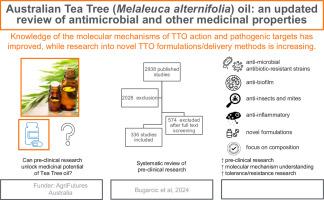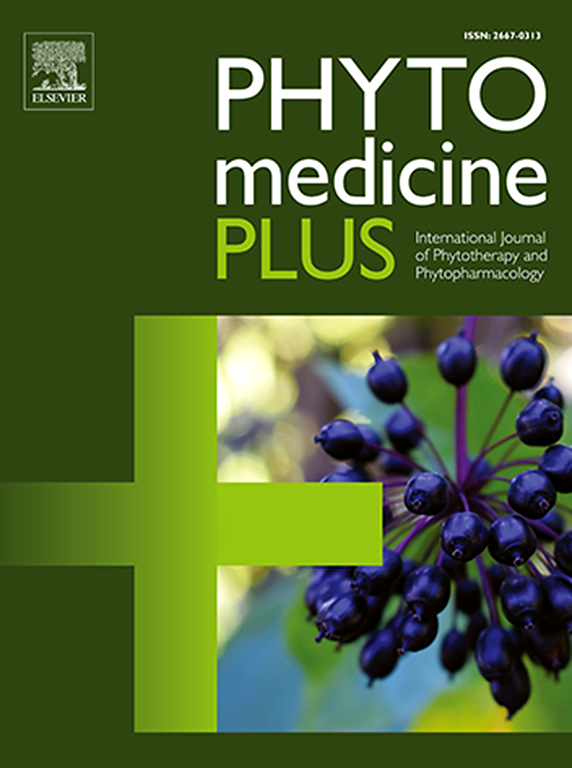Australian Tea Tree (Melaleuca alternifolia) oil: an updated review of antimicrobial and other medicinal properties
Q3 Pharmacology, Toxicology and Pharmaceutics
引用次数: 0
Abstract
Background and Purpose
The last comprehensive review of the effects of tea tree oil (steam distilled essential oil of Melaleuca alternifolia; henceforth TTO) was conducted in 2006 by Carson and colleagues (Carson et al., 2006). Here, we provide an updated review focused on the antimicrobial (including antibacterial, antiviral, antifungal and anti-parasitic) and anti-inflammatory effects of TTO, as well as a discussion on novel TTO formulations for these specific actions.
Study Design and Methods
A systematic review of studies was conducted using PubMed and Scopus electronic databases with a defined search strategy and inclusion/exclusion criteria ensuring the selection of studies that investigated antimicrobial and anti-inflammatory actions of TTO in the context of pre-clinical research only.
Results
There has been a marked increase in the number of pre-clinical studies exploring the antimicrobial (n = 78) and anti-inflammatory (n = 14) actions of TTO since the Carson et al. (2006) review. These studies have extended our understanding of TTO as an antimicrobial agent, with an emphasis on biofilm-forming, clinical, and drug-resistant strains, investigation of the susceptibility of fungi (specifically Candida spp.), and investigation into different pathogenic classes to identify antiviral and anti-protozoan actions. Studies investigating the anti-inflammatory activity of TTO improved our understanding of TTO mechanisms of action and novel directions in formulation and delivery of TTO as a preventative and therapeutic agent showing promise in vitro and in vivo.
Conclusion
Since the last review almost two decades ago, a significant body of pre-clinical research has been published concerning the antimicrobial and other therapeutic properties of TTO. These studies have expanded our understanding of the value of TTO in treating infections caused by different microorganisms, including more clinically relevant, health-related pathogenic states of bacteria and fungi (e.g. biofilms, clinical samples, and drug-resistant strains) as well as viruses and protozoa. Research into novel TTO delivery methods and isolated pathogenic drug targets is increasing and will be an ongoing requirement for further clinical research and applications.

澳大利亚茶树(千层树)油:抗菌和其他药用特性的最新综述
背景与目的茶树油(互生千层蒸汽蒸馏精油)的药理作用综述;(以下简称TTO)是Carson及其同事于2006年进行的(Carson et al., 2006)。在此,我们主要介绍了TTO的抗菌(包括抗菌、抗病毒、抗真菌和抗寄生虫)和抗炎作用的最新进展,并讨论了具有这些特定作用的新型TTO配方。研究设计和方法使用PubMed和Scopus电子数据库对研究进行了系统回顾,并制定了明确的检索策略和纳入/排除标准,以确保选择仅在临床前研究背景下研究TTO抗菌和抗炎作用的研究。结果自Carson et al.(2006)综述以来,探索TTO抗菌(n = 78)和抗炎(n = 14)作用的临床前研究数量显著增加。这些研究扩展了我们对TTO作为抗菌药物的理解,重点是生物膜形成,临床和耐药菌株,真菌(特别是念珠菌)的敏感性调查,以及对不同致病类别的调查,以确定抗病毒和抗原生动物的作用。对TTO抗炎活性的研究提高了我们对TTO作用机制的理解,并为TTO作为一种具有体外和体内前景的预防和治疗药物的配方和递送提供了新的方向。自近20年前的上一次回顾以来,关于TTO的抗菌和其他治疗特性的临床前研究已经发表了大量。这些研究扩大了我们对TTO在治疗由不同微生物引起的感染方面的价值的理解,包括更多临床相关的、与健康相关的细菌和真菌致病状态(例如生物膜、临床样本和耐药菌株)以及病毒和原生动物。对新型给药方法和分离致病性药物靶点的研究正在增加,这将是进一步临床研究和应用的持续需求。
本文章由计算机程序翻译,如有差异,请以英文原文为准。
求助全文
约1分钟内获得全文
求助全文
来源期刊

Phytomedicine Plus
Medicine-Complementary and Alternative Medicine
CiteScore
3.70
自引率
0.00%
发文量
178
审稿时长
81 days
期刊介绍:
 求助内容:
求助内容: 应助结果提醒方式:
应助结果提醒方式:


